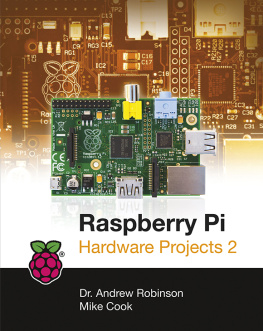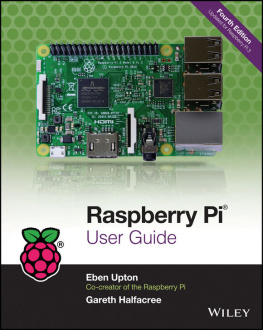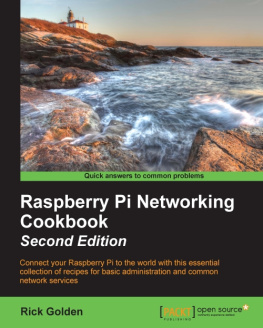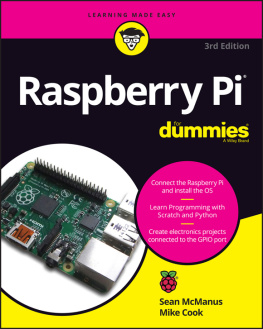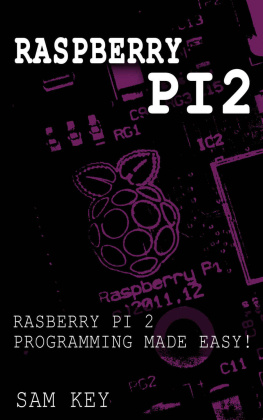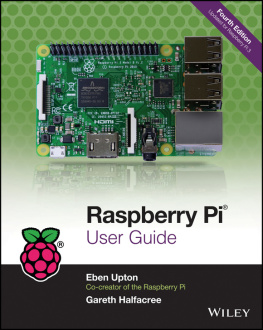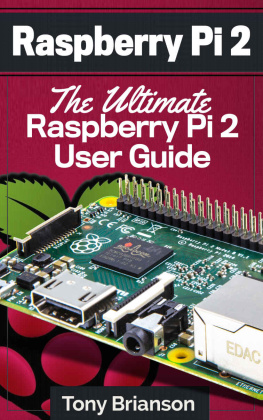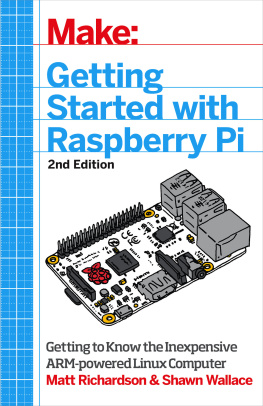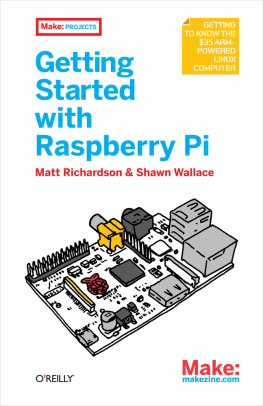This book isdedicated to my parents who always encouraged me to live the dream.
Chapter 1- An Overview of Raspberry Pi
When Raspberry Pi, thecredit-card-sized single-board computer developed by the Raspberry PiFoundation in the UK was launched, the concept of multi-purpose, lightdistribution platforms for promotion of teaching of basic computer science inschools was born. At present, Element 14/Premier Farnell and RS Componentscompanies license sales of Raspberry Pi. The Raspberry Pi Foundation worksactively toward innovation and integration of new hardware and softwareupdates.

Raspberry Pi is programmed in Pythonprogramming language. One of the most standard programming codecs available,Python is used to create compatibility in operating systems, infrastructure andsoftware programs used by Raspberry Pi. Python is a programming language thatis fairly easy to learn. By creating classes of scripted code, concepts can beexpiated in summary form so that programming results are accessible to conductcommands on the spot.
Online programming communitiesdedicated to creation of new software application as system (SaaS) are acentral part of the knowledge sharing world Python programming for Raspberry Piand its open source transformation. The Raspberry Pi platform supportsintegration with all of the major operating systems available in digitalcomputer board based devices on the market, including is a cross-platformapplication Linux frameworks.
Features
Raspberry Pi is a Broadcom BCM2835system on a chip (SoC) with an ARM1176JZF-S 700 MHz processor and VideoCore IVGPU. The current Raspberry Pi system is 512MB, upgraded from 256 megabytes ofRAM. At present, the Raspberry Pi Foundation offers Arch Linux ARM and Debiandistributions for download.
Architecture
Visual diagram of API connections inthe Raspberry Pi utilizes Linux kernel-based operating systems. Raspbian is theDebian-based free operating system used to optimize Raspberry Pi hardware. Theboards GPU hardware is accessed by way of a firmware image or binary blob;loaded into the GPU when booted from the SD-card. The firmware image is closedsource at present.
The processing functions within theboards application software source run-time libraries to access an open sourceAPI driver, inside the Linux kernel. Video applications employing 2D and 3Dapplications, OpenMAX and OpenGL ES use OpenVG and EGL. The boards new proofof concept SD card image reinforces the preliminary operating system. The imagecan run in QEMU which enables Raspberry Pi to be mirrored on other platformarchitecture.
System Software
Raspberry Pi Fedora Remix softwareapplication is the one of the most recent developments for Linux distribution.The 2012 release was part of an ongoing effort in App exchange to upgradeefficiencies in the operating system. Systems software also includes SlackwareARM version 13.37. Free VideoCore driver code runs the Raspberry Pi ARM, isanother example of open source multimedia SoC software available to the public.
Operating Systems
Raspberry Pi is compatible with anumber of standard operating systems running that are ported or in the processof port integration. Operating systems compatibility includes cross platformapplications frameworks developed for solely for Raspberry Pi's integration ofLinux distribution.
Multi-purpose distributions inMoebius offer light ARM HF. Application of Moebius in Raspberry Pi isostensible as it is small enough for 1GB SD memory. So minimal in memory usage,in fact, is Moebius that it optimizes the Raspberry Pi operating system withthe least possible consumption. Finally,single purpose light distributions suchas IPFire and Raspbmc are available for Raspberry Pi integration withoutadditional programming.
User Applications
Raspberry Pi applications that caneasily be installed on Raspbian involve multimedia, audio, graphics, Smartphoneand LAN server functions. Open source media applications are built from outsidesources to create new formats for unique user programming. Communities ofprogrammers construct new software applications modules using the Pythonprogramming language, adding new information to dictionaries, lists and classeswithin the codec protocol.
Accessories
A prototype camera with 5 megapixelsis set for release in April 2013. The module tested by the Foundation is one ofthe many accessory features Raspberry Pi supports. The board also interfaceswith LEDs, analog signals, sensors, switches and other hardware devices, aswell as an Arduino compatible controller.
Hardware
Schematics to both Raspberry Pimodels (A and B) offer PCB connectors and ICs in block diagram. Model A doesnot include an internal connection to Ethernet. USB dongle can be employed toconnect to external Ethernet. Model B contains an embedded Ethernet feature.
While Raspberry Pi Model A does notcome with an Ethernet port, it can be connected to a network externally or byway of Wi-Fi adapter. There is no difference in performance between Model A andModel B in this regard, as internal Ethernet and external port connection offerthe same adaptation. Generic USB keyboards and mice are both compatible withRaspberry Pi.
Due to the fact that Raspberry Pidoes not include a clock with auto recognition, the operating systems must becommanded to access a network time server. This can also be achieved by way ofrequest for date stamping. Hardware accelerated video (H.264) encoding is alsonew. Two recent releases of codecs that can be integrated separately MPEG-2and Microsoft's VC-1 increases the capabilities of video in Raspberry Pi.
Raspberry Pi is slated to supportCEC which will allow for it to be controlled by way of television remotecontrol. Other recent innovations include a revision 2.0 board in response tosome minor update for corrections and improvement. Raspberry Pi Model B now hasa larger memory with 512MB RAM chips.
Chapter 2- Raspberry Pi- Python-What is it and What are the Benefits?
Raspberry Pi is a credit card sized,single-board computer under innovation by the Raspberry Pi Foundation UK. Themulti-purpose, light distribution platform is popular for teaching basiccomputer science in schools. The Raspberry Pi Foundation participates in the activedevelopment of Python programming language development of new hardware and softwareupdates for its system.





